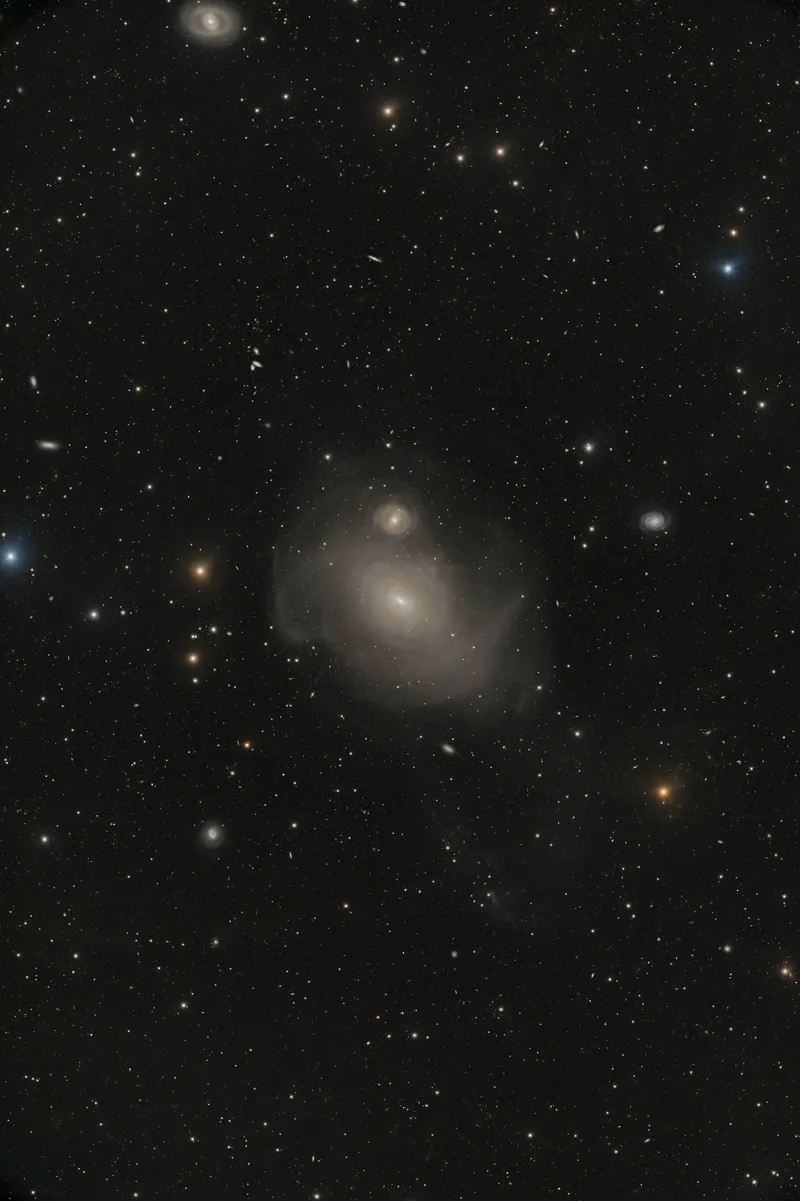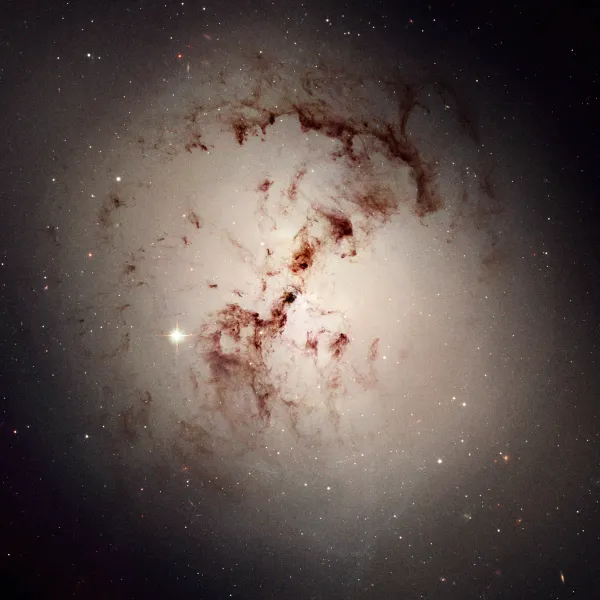Fornax A (NGC 1316)

History
James Dunlop discovered the galaxy D 548 (NGC 1316) on 2 September 1826 using his 9 inch reflector from Parramatta in New South Wales, Australia. He made two observations and described it with: «A rather bright, round nebula, about 1.5' diameter, gradually condensed to the centre.» On 24 November of the same year he discovered D 547 (NGC 1317) and noted: «A small faint round nebula about 15 arcseconds in diameter.» [50]
John Herschel observed this galaxy group on 22 October 1835 using his 18.3 inch reflecting telescope in South Africa and listed the galaxies as h2524 (NGC 1310), h2527 (NGC 1316) and h2529 (NGC 1317). Julius Schmidt found NGC 1318 on 19 January 1865 with the 6.2-inch refractor at the Athens Observatory. But his discovery was a duplicate entry for h2529 (NGC 1317) which had a typo of 20 degrees in NPD (north polar distance) that was corrected in the addendum of Herschels catalogue. [364]

In 1949 the radio source Fornax A was found and in 1954 identified with the galaxy NGC 1316. [654] Halton Arp listed 1966 the Fornax A radio source in his «Atlas of Peculiar Galaxies» as Arp 154 in the group #153-160 (disturbed with interior absorption). [199]
Physical Properties
NGC 1316 is a diffuse elliptical (type cD) galaxy, located on the outskirts of the Fornax cluster of galaxies, about 4° from the centre. Also known as Fornax A it is the third-nearest radiobright galaxy after NGC 5128 (Centaurus A) and M 87. It shows prominent radio lobe spanning 33'. A unusual low X-ray luminosity of the active galactic nucleus (AGN) suggests a declining activity in the past 100 million years. An S-shaped nuclear radio jet suggest interaction with interstellar matter. The galaxy shows optical evidence of a rich history of merging events. Merger and active galactic nuclei play an important role in galaxy evolution. They drive gas inflow to the central region and may also activate star formation. The distance to NGC 1316 is estimated to 20.8 ± 0.5 Mpc. [655]
| Name | RA | Dec | Type | bMag | vMag | B-V | SB | Dim | PA | z | D(z) | MD | Dreyer Description | Identification, Remarks |
|---|---|---|---|---|---|---|---|---|---|---|---|---|---|---|
| NGC 1310 | 03 21 03.5 | -37 06 08 | Gx (SBc) | 12.6 | 12.1 | 0.5 | 13.1 | 1.9 × 1.5 | 95 | 0.006021 | 25.43 | 19.720 | globular, vF, pL, R, vgvlbM | h 2524; GC 693; ESO 357-19; MCG -6-8-4; IRAS 03191-3716; FCC 13 |
| NGC 1316 | 03 22 41.4 | -37 12 28 | Gx (SB0) | 9.4 | 8.5 | 0.9 | 13.4 | 11 × 7.2 | 50 | 0.005871 | 24.80 | 20.130 | vB, cL, vlE, vsvmbMN | h 2527; GC 697; ESO 357-22; MCG -6-8-8; Arp 154; FCC 21; IRAS 03208-3723; AM 0320-372; Fornax A |
| NGC 1316 A | 03 23 37.9 | -36 54 14 | Gx (S0-a) | 14.9 | 14.0 | 0.9 | 12.2 | 0.7 × 0.3 | 60 | 0.040798 | 172.3 | vB, cL, vlE, vsvmbMN | h 2527; GC 697; MCG -6-8-8; FCC 192; IRAS 03217-3704 | |
| NGC 1316 B | 03 23 39.5 | -36 54 31 | Gx (Sab) | 15.1 | 14.3 | 0.8 | 11.8 | 0.4 × 0.3 | 5 | 0.065405 | 276.2 | vB, cL, vlE, vsvmbMN | h 2527; GC 697; MCG -6-8-9 | |
| NGC 1316 C | 03 24 58.4 | -37 00 33 | Gx (S0) | 14.4 | 13.4 | 1.0 | 13.4 | 1.6 × 0.7 | 85 | 0.006004 | 25.36 | 16.900 | vB, cL, vlE, vsvmbMN | h 2527; GC 697; ESO 357-27; MCG -6-8-12; FCC 33 |
| NGC 1317 | 03 22 44.2 | -37 06 12 | Gx (SBa) | 11.9 | 11.0 | 0.9 | 12.9 | 2.8 × 2.4 | 78 | 0.006474 | 27.35 | 16.900 | pB, pS, psbM | h 2529; GC 698; NGC 1318; ESO 357-23; MCG -6-8-6; FCC 22; IRAS 03208-3716 |
Finder Chart
The galaxy NGC 1316 is located in the constellation Fornax at a declination of -37° and is thus not visible from central Europe.
